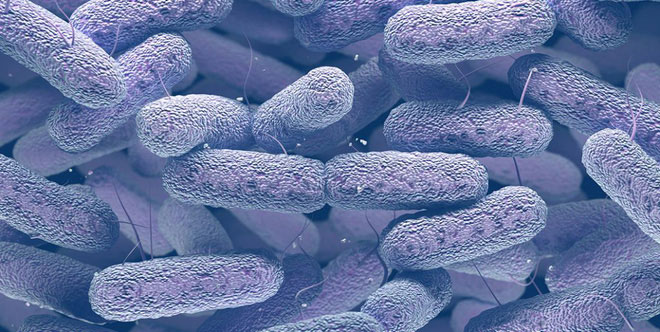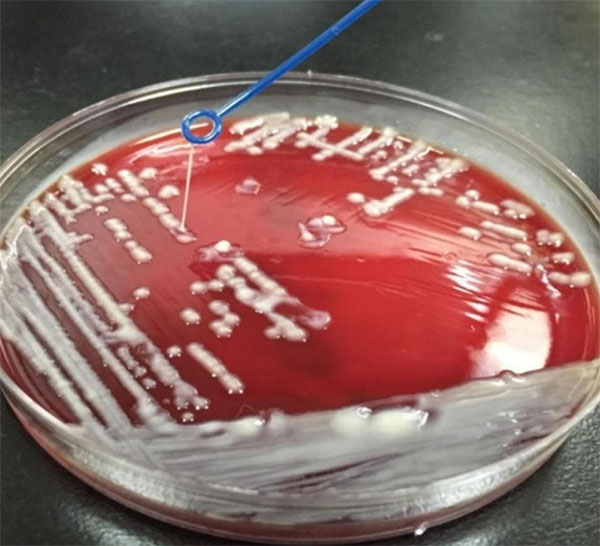The deadly bacteria in this day can explode when antibiotic resistance comes
A bacterium that doesn't seem to be very dangerous, but is now becoming a huge threat if humans don't find a way.
Klebsiella pneumoniae is a bacterium that can cause infection, but the danger is only moderate to humans. Even in the era of drug resistance, people are not too worried about K. pneumoniae, because it only affects older people, or has a weak immune system.
However, this is essentially a misconception. When developed, K. pneumoniae can cause many infections related problems, in which necrosis is capable of killing a healthy person within a day.

Bacterial Klebsiella pneumoniae.
And according to a new study, K. pneumoniae has a strain of bacteria that needs attention, because it's likely to become a nightmare of the coming era.
What's so horrible?
Typically, K. pneumoniae is just around the human digestive system. Occasionally, it appears on the skin or mouth, and does not cause any effect. Only people who already have very weak immune systems will be harmed.
But then everything changed in the 1980s, when doctors found a more aggressive, more dangerous and more dangerous strain of S. pneumoniae in Taiwan. He does not need a host to be ill to reveal himself, but he stays there. For then the patient suffered from cerebral edema, swelling of the liver, and extensive necrosis.

Finding out how to distinguish K. Pneumoniae and hvKp is extremely important
It is called hypervirulent K. pneumoniae (hvKp) . And it is worth noting that humans are still unable to recognize its presence. Until now, it is still not clear which types of K. pneumoniae are likely to turn into hvKp, until they cause serious damage it is late.
In front of this fact, experts from the University of Buffalo (USA) have proposed the most feasible proposal, which is to create an indicator chemical that helps distinguish these two bacteria.
Specifically, Thomas Russo from Buffalo University and many experts in the world have created a specific indicator for hvKp. It only reacts to this bacterium's DNA, and thus has very high reliability. However, this is still only the first step of a process, to find the longest and most sustainable solution.
"Currently, there is not any testing method to distinguish two types of bacteria," Russo said.
"This research gives us a clear way, so any organization can create a way to test them in the laboratory. It's really necessary."
In fact, the phrase "necessary" is still slightly reduced. In fact, drug-resistant bacteria from K. pneumoniae have been around for several years, and the consequences can be serious. If not distinguishable soon, real nightmares will occur if hvKp can also resist drugs.

hvKp can turn into, causing serious necrosis.
The situation is so serious that the World Health Organization WHO has set a target to manufacture this antibacterial antimicrobial drug on the level of priority. Although it has not left any noticeable consequences at the moment, people are still being put on guard.
According to Russo, just distinguishing hvKp is a huge success step. However, scientists need to map out a clear route, in order to get the necessary preparation when the era of drug resistance occurs.
How can hvKp become a nightmare?
There are two ways for it to happen. First, both strains will appear together, in which the drug-resistant K. pneumoniae will collect and re-encode the ability, discharging it into the environment to receive it.
The second way is that K. pneumoniae somehow absorbs the "cannibalism" ability of hvKp. And in fact, this second road has already appeared.
"There are at least 5 patients who died in Hangzhou, China because of the second form," Russo said.
There are many things to learn about this bacterium. Why does it appear so much in Asia? Is it the source, or is it just because the population here is too crowded? According to Russo, we need more research to answer this question.
The study is published in Clinical Microbiology.
- WHO put recommendations on what to do to prevent the spread of resistant bacteria
- How did bacteria learn to fight antibiotics?
- Bio-nano robot will help end the antibiotic resistance crisis
- 10 reasons why antibiotic resistance is scary right now
- Antibiotic resistance can be passed from mother to child
- The principle you must remember in an age of nightmares 'antibiotic resistance'
- Learn about the phenomenon of antibiotic resistance
- The CDC report states: The United States has entered a post-antibiotic period
- The scary truth about antibiotic-resistant bacteria
- £ 10 million for anyone to find a solution against antibiotic resistance
- Experts have warned about antibiotic resistance
- Solving the phenomenon of drug resistance by giving bacteria 'fighting' together
 The United Nations' all-human warning: All antibiotics are becoming useless
The United Nations' all-human warning: All antibiotics are becoming useless How did bacteria learn to fight antibiotics?
How did bacteria learn to fight antibiotics? 10 million deaths are one of the startling numbers about 'Antibiotic resistance'.
10 million deaths are one of the startling numbers about 'Antibiotic resistance'. Learn about the phenomenon of antibiotic resistance
Learn about the phenomenon of antibiotic resistance